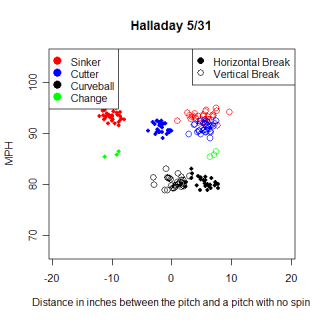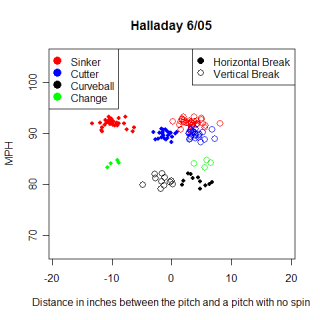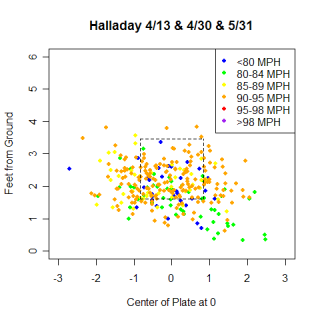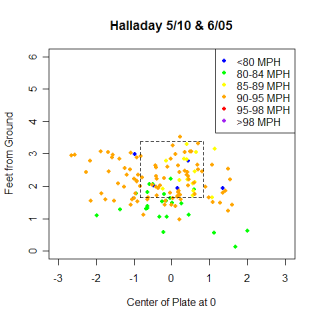
| Command Post | June 28, 2007 |
Why do pitchers struggle in some starts? Without thinking too hard, I would guess poor starts are based on some combination of bad luck, bad location and bad stuff. Everyone can see when a pitcher is missing his spots and bad luck can be reasonably quantified with DIPs, but what about bad stuff? Frequently an announcer will say that a pitcher "didn't have his best stuff tonight" as a reason for his poor showing. What does that statement really mean, and is there any truth to it?
Roy Halladay has made 14 starts this season, posting a record of 9-2 and an ERA of 4.25. He began the season on fire, going 4-0 in his first six starts, racking up 33 strikeouts against only seven walks and allowing just three home runs in 47.1 innings. Opponents were hitting just .207 against him and he already had thrown two complete games. However, after April 30th, Halladay hit a rough patch. His next two starts were awful as he allowed 16 runs over 10.1 innings. His ERA rose by more than two runs because of those starts and after his start on May 10th against the Red Sox he was diagnosed with appendicitis. One reason he may struggled in those two starts was because he was hurt and unable to pitch effectively. This appeared to be the case when, upon his return, he held the White Sox scoreless for seven innings on May 31st (7 IP, 0 ER, 6 H, 7 SO, 0 BB). However, in his very next start, he got lit up by the Devil Rays in his shortest outing of the season (3.1 IP, 7 ER, 12 H, 1 SO, 1 BB) . Why did he pitch so well against the White Sox on May 31st but get destroyed by Tampa Bay five days later? While focusing on the bigger issue of what makes a pitcher struggle in certain starts, I'm going to examine these two starts closely and see if I can find an explanation for the differences.
There are a million possible reasons why Halladay could have dominated in one start and been dominated in the next. Although the White Sox and Devil Rays are both weak offensively, there may have been a subtle difference between them that allowed the Devil Rays to have success. The Blue Jays defense might have played extra hard against the White Sox and taken the night off vs. Tampa. The mound might even have been raked differently or the balls were shinier in one start. The point is it could have been anything. Probably though, it wasn't something as small as the dirt on the mound and perhaps Halladay, fresh off the DL and 20 days of rest when he made his start against the White Sox, wasn't ready to resume pitching on a normal four days rest. He might not have been able to locate his pitches where he wanted and if he did locate them, the pitches themselves might not move like he wanted.
Here are two charts showing the movement of his pitches in each start.


Halladay has four pitches, a 2-seam sinker that moves in toward right-handed hitters, a cut fastball that sinks and moves away from right-handed hitters, a changeup that mimics the movement on his sinker and a curveball. Looking at the graphs there aren't many striking differences to see, which is surprising due to the different outcomes of the games. There are some slight differences in these Rorschach-esque patterns of pitch movement, but on average, the way the pitches behaved was remarkably consistent. One difference that isn't instantly recognizable is that median speed for his two fastballs and changeup was at least one MPH slower in the start on June 5th. This lends a little bit of support to the idea that Halladay wasn't quite ready to return to pitching on normal rest after his trip to the DL. One MPH doesn't seem like a big difference, and I think the difference is primarily due to Halladay being extremely rested after coming off the DL, as the slower speeds were more consistent with earlier starts that Halladay made this season. The table below lists the medians for each category.
Date Type Speed Pfx_x Pfx_z Break Length Percent 4/13 Fastball 90.5 MPH -9.98" 5.46" 7.6" 0.32 4/30 Fastball 92.1 MPH -10.28" 3.23" 8.9" 0.49 5/31 Cutter 91.3 MPH -1.79" 5.67" 6.5" 0.35 6/5 Cutter 89.9 MPH -1.12" 3.90" 7.6" 0.31 5/31 Curveball 80.3 MPH 5.62" 0.80" 12.0" 0.30 6/5 Curveball 80.6 MPH 4.37" -1.57" 12.7" 0.15 5/31 Changeup 85.8 MPH -9.17" 7.11" 8.2" 0.03 6/5 Changeup 84.2 MPH -9.64" 5.69" 9.3" 0.05
There aren't many differences in how his pitches moved between starts. The PITCHf/x system has a margin of error of plus/minus an inch, and only two parameters have differences of more than two inches, so most of the differences could be just noise. (There's also the problem with having a small sample for each pitch) The difference in vertical movement between starts on his curveball and fastball was more than two inches, with both pitches having greater drops on June 5th. It would seem that more movement on a pitch would be preferable, but Halladay's added movement didn't help him on June 5th. One other difference between the starts was that Halladay threw a lower percentage of curveballs on June 5th than on May 31st. I don't know if the difference means anything just by looking at these two starts, but it's interesting to note that the difference in curves was made up by throwing more fastballs. For whatever reason, on June 5th Halladay got no swings-and-misses with his curveball, but on May 31st, he had six swings-and-misses with his curve. Perhaps Halladay realized he couldn't get the results he needed with his curve on June 5th and went to his fastball, or he might have focused on his fastball if he thought he was going to have trouble throwing his curve around the strike zone.
The consistency of Halladay's pitches, regardless of the quality of his start, is striking. The table below details three starts he made in Toronto prior to going on the DL. Just from looking at the movement data, can you tell the difference between Halladay's 10 inning performance against the Tigers, a nine inning complete game where he allowed five hits, and the game when he allowed seven earned runs in five innings of work, possibly with appendicitis? There are a couple of differences among pitches between starts, mostly with his fastball and curve again, but nothing earth shattering. In fact, in cases like the vertical movement of the fastball, the value for the bad start is in between the values of the good starts. The start on April 13 was the 10 inning complete game and April 30 was the five-hitter. The start on May 10 was the stinker and his last start before going on the DL.
Date Type Speed Pfx_x Pfx_z Break Length Percent 4/13 Fastball 90.5 MPH -10.85" 4.40" 9.0" 0.57 4/30 Fastball 92.7 MPH -11.08" 1.82" 9.3" 0.40 5/10 Fastball 91.9 MPH -10.81" 3.83" 8.8" 0.50 4/13 Cutter 89.6 MPH -3.46" 4.64" 7.6" 0.18 4/30 Cutter 91.7 MPH -3.92" 3.89" 7.4" 0.34 5/10 Cutter 90.5 MPH -3.65" 5.59" 7.0" 0.30 4/13 Curveball 79.7 MPH 3.05" -0.99" 12.6" 0.19 4/30 Curveball 80.3 MPH 5.83" -2.59" 13.4" 0.21 5/10 Curveball 80.9 MPH 4.99" -1.22" 12.6" 0.16 4/13 Changeup 83.1 MPH -10.38" 5.34" 9.5" 0.06 4/30 Changeup 84.8 MPH -9.94" 5.25" 9.3" 0.07 5/10 Changeup 84.0 MPH -10.46" 5.13" 9.6" 0.08
While his movement remains the same in good starts and bad, how effectively does Halladay locate the ball in both types of starts? Here are two charts, from the perspective of the catcher, that show the location of Halladay's pitches in his good starts (left) and bad starts (right).


There doesn't appear to be a lot of difference between the top groups of data. A higher percentage of the pitches are around the strike zone in his good starts and he throws a couple more pitches up in the strike zone and inside to right handed hitters in his bad starts, but the differences don't appear to be major. The location differs slightly depending on the quality of the start and that probably helps make a good start better or a bad start worse (although there is a chicken and egg question about whether location causes a start to be good or if location is good because a start is good).
The movement on Halladay's pitches stays very uniform from start to start. He might not have the same success each time, but it doesn't appear to be as a result of not having good stuff each time he takes the mound. However, while the small differences that I did see could be explained away because of the limitations of the technology, they might be real and contribute to his success or failure on any given start. More importantly, and something I didn't touch on at all is the interplay between the different possible movements for a pitch and how that impacts the rest of a pitcher's repertoire. If his fastball is moving in a particular fashion, does he throw certain percentages of curves and cutters? If his fastball is sinking more, how does that impact the horizontal movement on it? How much can he control the movement of a pitch? Can he tell how his pitches are moving to make those adjustments? Halladay has had success with a range of horizontal and vertical movements on his fastball, so perhaps his pitches all work in harmony to create the effect having a constant amount of movement on his fastball (or curve or any pitch).
I haven't looked at other pitchers besides Halladay to see if the pattern of consistent movement across starts is true in general. Obviously Halladay is a very good pitcher, so it makes sense that he is able to maintain his skills for many starts in a row, and is more likely to get shelled because of bad luck than because his pitches are suddenly flat. I would guess that a less skilled pitcher would experience more of a change in the movement of their pitches in a good start vs. a poor start.
Comments
I love the "didn't have his best stuff" today idea being debunked. Playing baseball for over 20 years taught me that more often than not, the guy's stuff is his stuff, good day or bad day - it usually didn't vary all that much.
Posted by: matty b at June 29, 2007 10:32 AM
I would guess that a less skilled pitcher would experience more of a change in the movement of their pitches in a good start vs. a poor start.
I doubt it. I'm pretty sure that you would find that good pitchers, bad pitchers, lefty or righty, starter or reliever, whatever......their "stuff" is probably pretty consistent appearance to appearance. Except when they're injured, then you'd find a big difference in movement and velocity.
Random occurence accounts for the huge majority of difference in a pitchers performance outcome from game to game.
Posted by: Nathaniel Dawson at June 29, 2007 7:48 PM
When a pitcher gives up runs, he is almost always blamed for a bad performance. People forget that major league hitters have amazing skills. You have to expect the Ryan Howard types to smack the ball over the fence at times and the high-average guys to get two and three hits when they're locked in.
In more than a few cases, multi-run innings will include some bloopers and groundball singles. That doesn't mean the pitcher got hammered. It's just the law of averages and possibly poor positioning by the defense.
Posted by: Al Doyle at June 30, 2007 8:27 AM
I don't know if that's true, Nathaniel. How about a guy like Oliver Perez, who used to look amazing one start and then completely lost the next? I've seen people attribute it to him not finding a consistent release point, I'd love to see the Gameday data used to see if this is true or not. Unfortunately, I don't think a lot of Perez's starts have been tracked.
There was a funny sequence earlier in the year though with Perez. He dropped down to sidearm on a pitch, and SNY shows a shot of Peterson after the pitch staring blankly and dropping his head down.
Posted by: Dan at June 30, 2007 10:40 AM
Awesome blog! Thanks for the insightful commentary. I just wanted to tell you, when you write new blog posts, go over to BeTheRef.com and post a link to your story, and hopefully get a few extra readers. Keep up the good work and have a great weekend!
Posted by: Justin at June 30, 2007 5:30 PM
Dan, you may be right about Oliver Perez........What I said was the "vast majority" yadda yadda. There are other influences that come into play, including times when a pitcher might be pitching with a slight "twinge" or the early beginnings of an injury. Or a guy may be slightly under the weather, like we all get sometimes, or working through a severe hangover. There are certainly other things that can come into play, but I think only rarely. Most of the difference you see, yeah, that's just random occurence.
Posted by: Nathaniel Dawson at July 1, 2007 9:23 PM
Perez i believe has had two starts with the enhanced gameday. I downloaded the xml files but I havent looked at them yet.
Posted by: john at July 2, 2007 1:56 PM
This might be a silly question but what program do you guys use to do those scatter plot charts?
Posted by: john at July 3, 2007 12:34 PM
Sorry about taking so long to get back to these comments/questions, but here's what I've got, starting from the top.
Nathaniel/Dan-What I meant by that quote was that perhaps one thing that helps make Halladay so good is that the movement on his pitches is consistent from start-to-start. It really was a guess how other pitchers would far, but I'm taking a little closer look at it and should have something for this Weekend blog. There has to be some randomness, but maybe certain pitchers have a tendency to vary their stuff from start to start.
Al-I'm think there is a DIPs connection to be made with these data once Gameday tracks every game.
john-Perez does have 2 full starts in Gameday parks, both in Atlanta. He did make one start in Washington when the system was being tested, but fewer than 40 pitches were captured that game. I use R (http://www.r-project.org/) to make my plots.
Posted by: joe p at July 3, 2007 6:35 PM
Thanks. I was doing them in Excel but they didnt look as good.
Posted by: john at July 4, 2007 10:33 AM